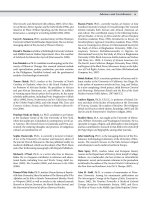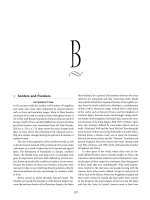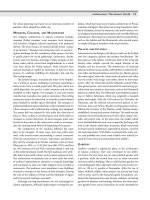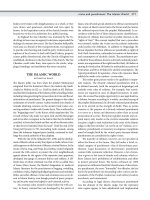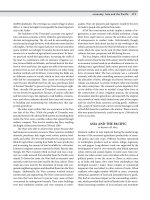Encyclopedia of society and culture in the medieval world (4 volume set) ( facts on file library of world history ) ( PDFDrive ) 497
Bạn đang xem bản rút gọn của tài liệu. Xem và tải ngay bản đầy đủ của tài liệu tại đây (55.98 KB, 1 trang )
470 forests and forestry: The Americas
Forestry and Culture
Despite modifications in the forests that medieval Americans might have made, the fact remains that when the first
European settlers arrived, they were met by two continents that in many places were densely forested, particularly in
the eastern regions where the first Europeans put down roots.
Forestry practices at this point in history came into conflict with one another. In North America, for instance,
several factors influenced the way Native Americans managed the forests that surrounded them. One factor was technology. Without the iron tools that were the product of European manufacture, Native Americans were limited in the
types of forests they could clear and the extent to which they could clear them. Simply put, they were unable to clear
large old-growth trees that in many instances were hundreds of years old, because their stone tools were unequal to
the task. In contrast, the first European settlers brought with them iron tools that enabled them to cut such trees.
A second factor was the sheer immensity of the Americas. During the medieval period Europe was beginning to
get crowded, and in many places old-growth forests had long been cleared. This was particularly the case in England,
where old-growth oak forests were essentially gone by late in the medieval period. The English, occupying a relatively
small island, had developed a long tradition of modifying their restricted environment to create farms, pastures, and
gardens. Water wheels and windmills were common sights. When these settlers arrived in the Americas, they saw vast
forests that appeared to them to be inexhaustible. It is little wonder, then, that they used wood for every conceivable
purpose: to build plank roads, homes, and wagons; as firewood; to make tools; and to produce charcoal for iron
production. In contrast, while Native Americans modified the forests, it is also the case that they allowed forests to
regenerate over periods of hundreds of years. They cleared an area for farming and when the soil became depleted,
they moved on to another area, allowing the earlier area to return to its natural state.
A third factor was philosophical and religious. Native Americans tended to regard the forests as sacred. The forests were home to animals and plants that provided them with sustenance. They saw themselves as just one of many
species that occupied the forests. In contrast, the first European settlers were frightened of the forests. Forests in the
popular imagination were occupied by spirits, witches, and demons as well as by various predatory species—bears,
cougars, wolves, and similar animals that turned the forests into what the English called a “howling wilderness.” It
was a place where a person could easily become lost—the English word bewildered literally means “lost in the woods”
or “lost in the wild.” One reason that the first settlers distrusted Native Americans was that the natives seemed
comfortable living and moving about in the forests. To medieval Native Americans, forests were home. To the first
settlers, forests were something that had to be tamed.
tic herds in the Mayan area. Progressively less productive
land was available, leading to population decline and, along
with other factors, the eventual fall of the Maya as a major
power in the area.
In the Peruvian Andes more than 1.5 million acres of
terraced fields can still be seen, and historians believe that
many millions more were under slash-and-burn cultivation.
Historians, archaeologists, and botanists differ sharply about
pre-Columbian forests and forest-management practices,
particularly in the Amazon basin, which is home to an immense rain forest. The region has come to the attention of
the public as scientists have learned more about the role of
rain forests in absorbing carbon dioxide and releasing oxygen
into the atmosphere. Many contemporary environmentalists
vigorously oppose cutting down rain forests for agriculture.
They regard the shrinking of the Amazon rain forests as symbolic of human degradation of the environment.
The traditional view is that pre-Columbian Amazonians
lived in harmony with the rain forest and that human activities had only a very limited impact on it—again, the myth
of the pristine wilderness. Other scientists, however, dispute
this viewpoint, and some even contend that the rain forest
as it is known today is in many respects a human creation.
These scientists note that the soil in much of the Amazonian
rain forest has always been poor, primarily because nutrients
leech away in the persistent rain. The conventional belief is
that for this reason, populations were limited to small bands
who cleared relatively small areas of forest and then left when
the soil was no longer able to produce crops. The forest reasserted itself until a new group came in and began the process all over again. However, some historians are revising this
conventional view. They note that clearing rain forest without
the benefit of modern machinery is an immensely difficult
process—so difficult that few people during the pre-Colum-

